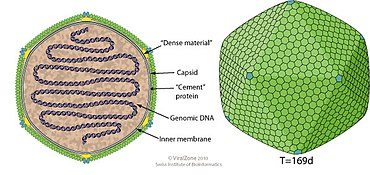| Prymnesiovirus | |
|---|---|
| Virus classification | |
| (unranked): | Virus |
| Realm: | Varidnaviria |
| Kingdom: | Bamfordvirae |
| Phylum: | Nucleocytoviricota |
| Class: | Megaviricetes |
| Order: | Algavirales |
| Family: | Phycodnaviridae |
| Genus: | Prymnesiovirus |
Prymnesiovirus is a genus of viruses, in the family Phycodnaviridae . Alga serve as natural hosts. There is only one species in this genus: Chrysochromulina brevifilum virus PW1 (CbV-PW1, Prymnesiovirus brevifilum). It infects Haptolina brevifila, basionym: Chrysochromulina brevifilum (Edvardsen et al., 2011). [1] [2] [3] [4]
